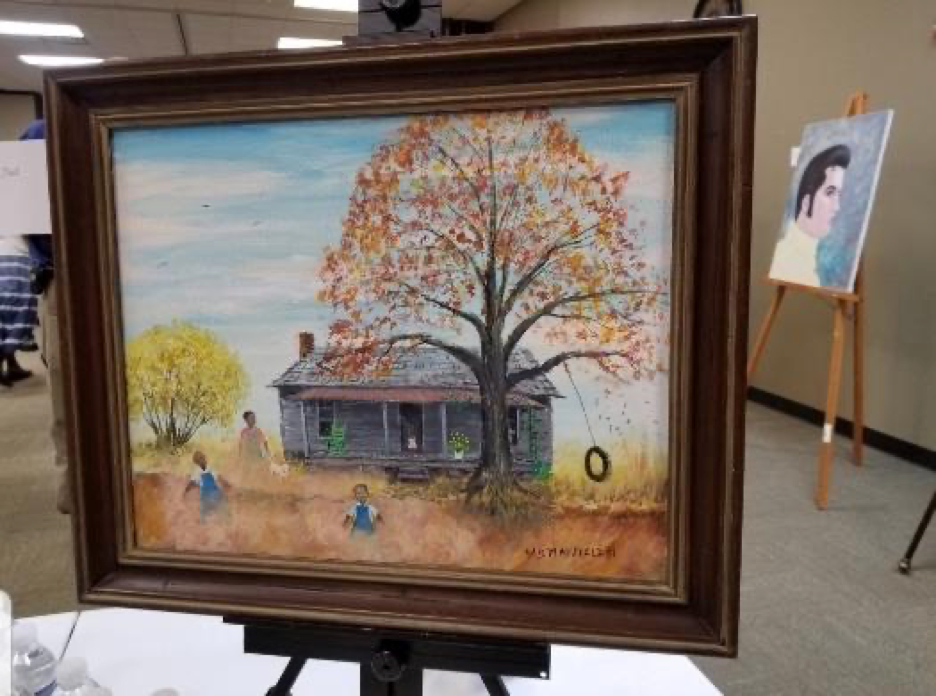M.B. Mayfield

The artist M.B. Mayfield painted this landscape of rural Mississippi. Born in 1923 in Ecru, Mississippi, Mayfield was best known for his painting and sculpting. He came to the University of Mississippi when Professor Stuart Purser, the founder of the art department, saw one of his portrait busts and his drawings displayed on the porch of his home in Ecru and offered him a job as a janitor as well as an education. Mayfield moved to Oxford in the fall of 1949. Because the university was racially segregated until 1962 when James Meredith became the first Black student to enroll, Mayfield had to listen in on Purser’s classes from inside an adjoining broom closet with the door cracked open.
Until the age of 26, Mayfield was a self-taught artist who made his own art materials from the natural world, such as clay from the river and red zinnias for paint pigments. Later, he would use oil and acrylic paints to create rich shades of red, blue, and green for his landscapes, which are internationally known.
Mayfield’s paintings are generally classified under a subgenre of folk art called memory painting. The subject of this genre is usually a recollection of personal experiences and community. The works tend to place value on simplicity and a nostalgic outlook on the individual’s past. Memory painting was popularized by self-taught artists, primarily white rural women. The relatable slice-of-life style of these works has made them popular for decades, and many of these pieces express a deep sense of national and regional identity across America.
This painting depicts a happy scene of children playing in the dirt outside, accompanied by a white dog that makes an appearance in several of Mayfield’s works. It is a clearly nostalgic piece, showing a treasured memory of Mayfield’s childhood alongside his siblings. The house is small and the land is somewhat barren, but there are cheery flowers and a green rocking chair on the porch that complement the mood of the playing children. Mayfield creates nuance in many of his works, balancing the memory’s tone unlike other memory painters, who portray experiences with an idyllic vision. Mayfield portrays his memories as they happened, without as much exaggeration.
Mayfield also uses color and texture to create a landscape that is familiar to residents of Mississippi. The sky is a beautiful wash of blue and white, the ground is a rusty red, and the trees have taken on pleasant autumnal shades. The eye is also grabbed by bright spots such as the overalls, which direct the viewer to the main source of action in the painting: the brothers. Mayfield has also set a scene here: the dust kicked up by the boys and the diagonal line of the tire swing, perhaps suggesting a breeze or a recent leap, show action and the passage of time. This affirms that though this is a painting, the memory it depicts is not a snapshot but a fluid thing that shifts and changes as the artist comes back to it.
Mayfield died in 2005, but his memories live on through his artwork and the stories shared by the people who knew him. He was a skilled painter and sculptor who subverted the genre of memory painting both by working with memories that were not always pleasant and by being a young black man who was working in a genre dominated by older white women.
Gwen Pfrenger is an art history major at the University of Mississippi. She is the recipient of a Stamps Impact Prize, which she is using to design an exhibition for the M.B. Mayfield House Museum.
Bibliography
Kogan, Lee. “Memory Painting.” In The New Encyclopedia of Southern Culture: Volume 23: Folk Art, edited by Carol Crown and Cheryl Rivers, 133–38. University of North Carolina Press, 2013. http://www.jstor.org/stable/10.5149/9781469607993_crown.34.
Mayfield, M.B. The Baby Who Crawled Backwards, Pontotoc Historical Society, Langford and Associates, 2003.
Mayfield, M.B., Lambert, Austin. “Mayfield House”, April 1, 2021. https://egrove.olemiss.edu/mbm_art/7/.
